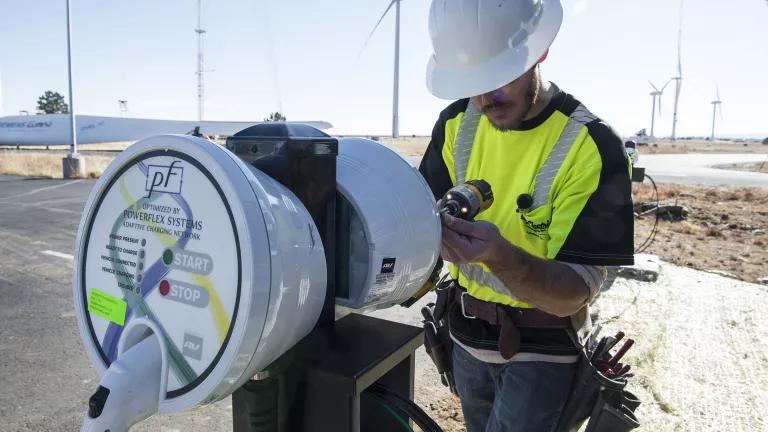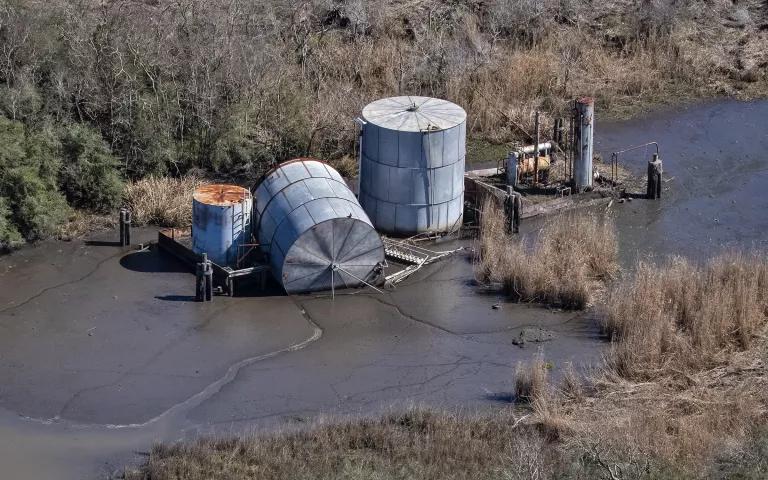Biden’s American Jobs Plan Is Also a Climate Plan
The $2 trillion it would invest in the country’s infrastructure and workforce will help the United States recover from the past while preparing for the future.

An Elite Electric worker connecting one of the new electric vehicle chargers at NREL's National Wind Technology Center in Golden, Colorado
Problems often overlap; solutions often don’t. But with his proposed American Jobs Plan, President Biden is attempting to address several different major crises facing the nation—a domestic unemployment crisis born of the COVID-19 pandemic, an ongoing racial justice crisis, and a global climate crisis—in a single stroke.
The United States is at a critical juncture. The pandemic exposed and exacerbated deep fissures and vulnerabilities in U.S. society: the race- and class-based inequities that mark our public health, criminal justice, labor, and education systems; the political and ideological divisions that impede consensus and cooperation; and the fragility of the economy and our infrastructures, both physical and social. If left to fester, these challenges will only deepen as the world warms and climate change continues to test the integrity of our society from myriad angles, including threats to our homes, health, landscapes, economy, food supply, and national security.
Joe Biden has vowed to rebuild the American economy in a way that addresses its structural weaknesses and inequalities. And as he told lawmakers during his joint address to Congress back in April, doing so requires “turning peril into possibility, crisis to opportunity, setbacks into strength.”
Opportunity is at the heart of the American Jobs Plan, first proposed by the president in late April and currently the subject of intense negotiations between the White House and congressional leaders of both parties. The sweeping package represents a historic attempt to strengthen the nation’s infrastructure—a word that the plan purposefully defines broadly to include high-speed internet, wetlands, and affordable housing as well as bridges, roads, and train tracks—all while creating millions of jobs. In revamping, and in some cases entirely reimagining, the elements that make up our built environment, the plan would also help rejuvenate our economy, put the unemployed and underemployed back to work, and advantageously reposition the United States on an increasingly competitive world stage.
But it has the potential to go even further: to fortify our defenses against the ravages of climate change. The plan envisions an America in which climate action is woven into the very fabric of our everyday lives and activities—a necessary measure if we’re to combat this existential threat in the decades to come.
Key to the plan is that every new program, every new initiative, every new project, every new everything is designed to create what Biden in his speech called “good-paying jobs that can’t be outsourced.” And as he further noted, nearly 90 percent of these jobs wouldn’t require a college degree—making the plan, in his words, “a blue-collar blueprint” for helping the country to become stronger, safer, and more climate resilient.
By framing it this way, the president preemptively rebuts the bad-faith arguments of those who claim that climate action would cost jobs, especially blue-collar ones. He also calls on Congress to ensure these investments come with local-hire provisions and apprenticeship programs and offer workers labor protections, prevailing wages, and the right to unionize. With the American Jobs Plan, Biden wants to show that strong climate policy is also smart economic policy. If paired with the proposed Made in America Tax Plan—which would raise corporate tax rates so that the largest corporations (some of which pay $0 annually in federal taxes) contribute their fair share—the approximately $2 trillion worth of investments the jobs plan calls for could be recouped within 15 years.
Here’s a look at just a handful of the climate and employment dividends these investments could yield.
A Catalyst for the Clean Energy Economy
The American Jobs Plan calls for investing $35 billion toward boosting research and development for emerging clean energy technologies—such as battery storage, carbon capture and sequestration, hydrogen energy, and offshore wind—that will help the United States achieve its goal of cutting its carbon emissions in half by 2030. The administration plans to provide tax credits to companies that invest in or generate energy from clean sources, such as solar, and that manufacture electric vehicles and their parts. And by updating federal procurement policies to prioritize clean energy, it hopes to leverage the government’s purchasing power to expand this already fast-growing market. The plan also offers prevailing wage and labor protections, local hire provisions, and registered apprenticeship programs.
Cheaper, Cleaner Electricity
The establishment of a new federal Energy Efficiency and Clean Energy Standard, which the American Jobs Plan calls for, would work to rid the U.S. power sector entirely of fossil fuels by 2035 through generating electricity via carbon-free sources and conserving that power with energy-saving measures. The plan would also create an investment tax credit to spur the construction of at least 20 gigawatts of high-voltage capacity power lines. Both initiatives would go hand in hand with modernizing the power grid, a $100 billion investment that would create hundreds of thousands of new jobs as workers fanned out across the country laying thousands of miles of new transmission lines—using American-made parts and materials to do it.

Effective and Equitable Climate Resilience
In recent years, we’ve seen the toll that extreme weather—in the form of drought, wildfires, floods, hurricanes, and other severe storms—can take on our homes, cities, economy, and lives. Along with improvements to the electric grid and hospitals, Biden’s plan would allocate at least $50 billion to transportation, food, stormwater, and drinking water systems—infrastructure that will make us stronger and more nimble when confronted with disaster. Significantly, the plan would target its investments, tax credits, grants, and other incentives to serve those people who are most often in harm’s way during states of emergency: residents of low-income areas and communities of color. In addition to strengthening our human networks and responses, the American Jobs Plan would also bolster our nature-based infrastructure to help communities weather these storms. Billions more would go toward protecting and restoring lands, forests, wetlands, watersheds, and other resources that we depend on—and according to the Center for American Progress, those initiatives would create as many as 700,000 new jobs in the process.
A Transportation Revolution
State and local governments and their private-sector partners would receive $15 billion to add 500,000 new electric vehicle chargers across the country over the next decade. The plan also calls for the replacement of at least 50,000 diesel transit vehicles in government fleets and the electrification of at least one-fifth of the country’s public school buses. Another $85 billion would be dedicated to modernizing our mass transit systems—double the amount of federal funding that they currently receive. Separately, $45 billion would go toward addressing inequities in our transportation system, with nearly half of that amount spent on programs that would, as the plan states, “reconnect neighborhoods cut off by historic investments and ensure new projects increase opportunity, advance racial equity and environmental justice, and promote affordable access.”

Capping Old Wells and Reclaiming Old Mines
Across the country, hundreds of thousands of abandoned mines and “orphan” oil and gas wells are leaking dangerous substances, including benzene and methane, many decades after they ceased operating. These relics of the fossil fuel industry continue to pose threats to drinking water supplies, climate, and, in some cases, even schools and homes. Biden’s plan would invest $16 billion and hire hundreds of thousands of workers to plug these wells and clean up these mines—many of which are found in economically deprived rural communities that have been neglected for too long.
Other parts of the American Jobs Plan address water infrastructure ($111 billion to ensure safe drinking water, including $45 billion to replace 100 percent of the lead pipes and service lines in the country); the modernization of buildings to maximize energy efficiency ($213 billion to construct or retrofit more than two million homes and $40 billion to improve our affordable housing stock); and the elimination of billions of dollars of federal tax breaks for fossil fuel companies once and for all.
Among other things, laying the foundation for an equitable, clean energy economy means going big. But given the scale of the country’s current problems, we can’t afford to think small. The American Jobs Plan is the plan we need for this moment—when both our present and future are on the line.
This NRDC.org story is available for online republication by news media outlets or nonprofits under these conditions: The writer(s) must be credited with a byline; you must note prominently that the story was originally published by NRDC.org and link to the original; the story cannot be edited (beyond simple things such as grammar); you can’t resell the story in any form or grant republishing rights to other outlets; you can’t republish our material wholesale or automatically—you need to select stories individually; you can’t republish the photos or graphics on our site without specific permission; you should drop us a note to let us know when you’ve used one of our stories.

Flooding and Climate Change: Everything You Need to Know
1.5 Degrees of Global Warming—Are We There Yet?
How to Find Relief During Summer Heat Waves in the City
Flooding and Climate Change: Everything You Need to Know
1.5 Degrees of Global Warming—Are We There Yet?
How to Find Relief During Summer Heat Waves in the City
Flooding and Climate Change: Everything You Need to Know
1.5 Degrees of Global Warming—Are We There Yet?
How to Find Relief During Summer Heat Waves in the City
Flooding and Climate Change: Everything You Need to Know
1.5 Degrees of Global Warming—Are We There Yet?